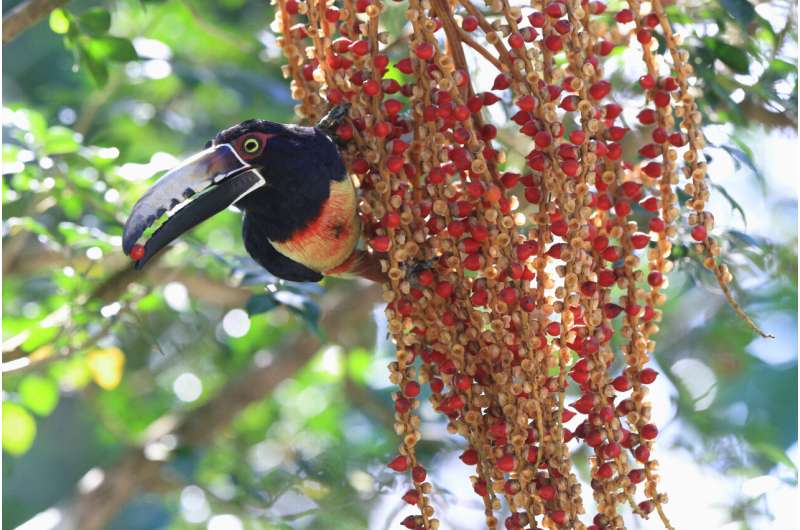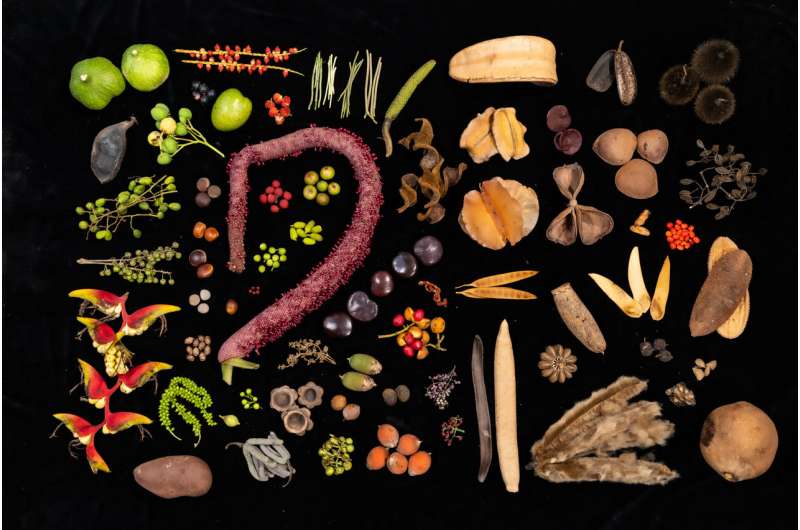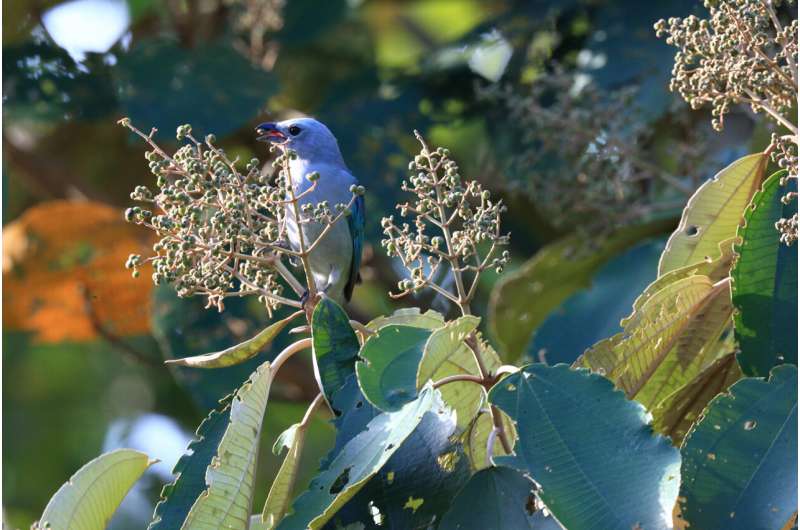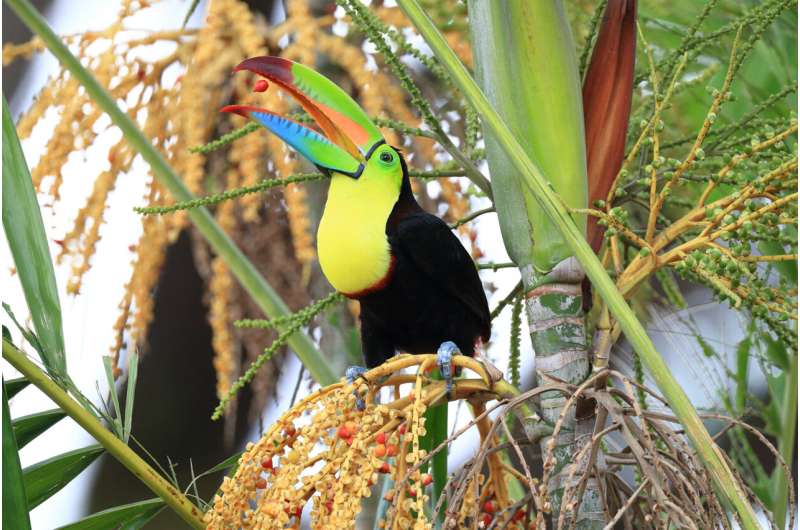Tropical forests can't recover naturally without fruit eating birds, carbon recovery study shows

New research from the Crowther Lab at ETH Zurich illustrates a critical barrier to natural regeneration of tropical forests. Their models—from ground-based data gathered in the Atlantic Forest of Brazil—show that when wild tropical birds move freely across forest landscapes, they can increase the carbon storage of regenerating tropical forests by up to 38%.
Fruit eating birds such as the Red-Legged Honeycreeper, Palm Tanager, or the Rufous-Bellied Thrush play a vital role in forest ecosystems by consuming, excreting, and spreading seeds as they move throughout a forested landscape.
Between 70% to 90% of the tree species in tropical forests are dependent on animal seed dispersal. This initial process is essential for allowing forests to grow and function. While earlier studies have established that birds are important for forest biodiversity, researchers at the Crowther Lab now have a quantitative understanding of how they contribute to forest restoration.
The new study, published in the journal Nature Climate Change provides evidence of the important contribution of wild birds (frugivores) in forest regeneration. Researchers compared the carbon storage potential that could be recovered in landscapes with limited fragmentation, with that of highly fragmented landscapes. Their data shows that highly fragmented landscapes restrict the movement of birds, thereby reducing the potential of carbon recovery by up to 38%.
Across the Atlantic Forest region in Brazil, the researchers found that it is critical to maintain a minimum of 40% forest cover. They also find that a distance of 133 meters (approximately 435 feet) or less between forested areas ensures that birds can continue to move throughout the landscape and facilitate ecological recovery.

The study also found that different bird species have different impacts in terms of seed dispersal. Smaller birds disperse more seeds, but they can only spread small seeds from trees with lower carbon storage potential. In contrast, larger birds such as the Toco toucan or the Curl-crested jay disperse the seeds of trees with a higher carbon storage potential. The problem is that the larger birds are less likely to move across highly fragmented landscapes.
"This crucial information enables us to pinpoint active restoration efforts—like tree planting—in landscapes falling below this forest cover threshold, where assisted restoration is most urgent and effective," Daisy Dent, a Lead Scientist in the Crowther Lab at ETH Zurich.
Restoring functioning ecosystem services
"Allowing larger frugivores to move freely across forest landscapes is critical for healthy tropical forest recovery," says Carolina Bello, a post-doctoral researcher also in the Crowther Lab at ETH Zurich and lead author of the study. "This study demonstrates that especially in tropical ecosystems seed dispersal mediated by birds, plays a fundamental role in determining the species that can regenerate."

Based on current data, this study advances the research from previous ground studies conducted by the authors in the Atlantic Forest in Brazil. The forest is one of the most biologically diverse regions in the world, but it is also one of the most fragmented with only 12% of the original forest remaining and in small areas.
The forest is also one of the most important regions on the planet for large-scale ecological restoration, with 12 million hectares of land targeted for restoration and natural recovery under the Atlantic Forest Restoration Pact. The research shows that increasing forest cover beyond 40% may be critical not only to maintain species diversity, as previously evidenced, but also to maintain and restore the functioning of ecosystem services, such as seed dispersal and carbon storage, to maximize the success of the massive-scale restoration initiative in this region.
"We have always known that birds are essential, but it is remarkable to discover the scale of those effects," says Thomas Crowther, Professor of Ecology at ETH Zurich, and the senior co-author of the study. "If we can recover the complexity of life within these forests, their carbon storage potential would increase significantly."
Strategies for recovering tropical forests
Earlier research suggests that recovering forests could capture more than 2.3 billion metric tons of carbon in the Atlantic Forest region, and that natural regeneration is likely to be more cost-effective—as much as 77% less in implementation costs—than active planting.

Researchers note that a range of strategies, such as planting fruit trees and preventing poaching, could enhance animal movement in tropical areas where passive restoration is more likely. Active restoration is necessary in highly fragmented landscapes.
"By identifying the thresholds of forest cover in the surrounding landscape that allow seed dispersal, we can identify areas where natural regeneration is possible, as well as areas where we need to actively plant trees, allowing us to maximize the cost-effectiveness of forest restoration," says Danielle Ramos, a co-author of the paper affiliated with the University of Exeter, UK and Universidade Estadual Paulista, Rio Claro, São Paulo, Brazil.
More information: Frugivores enhance potential carbon recovery in fragmented landscapes, Nature Climate Change (2024). DOI: 10.1038/s41558-024-01989-1
Journal information: Nature Climate Change
Provided by ETH Zurich Rainforest's next generation of trees threatened 30 years after logging
No comments:
Post a Comment